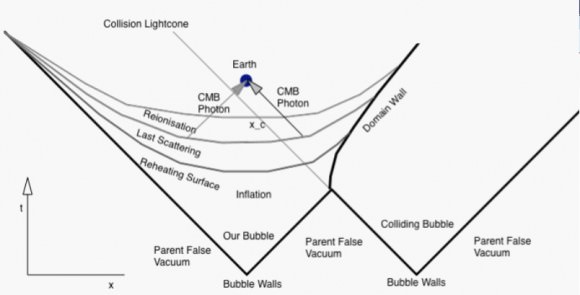[/caption]
One model of a hypothetical multiverse has, perhaps appropriately, some similarity to a glass of beer. Imagine an eternal false vacuum – that’s a bit like a fluid, though not all that much like a fluid – since it doesn’t have volume, in fact it doesn’t have any spatial dimensions. Then imagine that this eternal false vacuum expands.
This sounds rather contradictory since expansion implies there are spatial dimensions, but a string theorist will assure you that it all happens at the sub-Planck scale, where lots of immeasurable and unknowable things can happen – and after a few more drinks you might be willing to go along with this.
So – next, we introduce bubbles to the false vacuum. The bubbles – which are essentially independent baby universes – are true vacuums and can rationally and reasonably expand since they have four overt dimensions of space-time – albeit they may also have the other immeasurable and unknowable dimensions in common with the encompassing false vacuum.
The bubbles are the reason why it is necessary for the false vacuum to expand, indeed it must expand faster than the bubbles – otherwise an expanding bubble universe could ‘percolate’ – that is, spread throughout the all-encompassing false vacuum – so that your multiverse would just become a universe. And where’s the fun in that?
Anyhow, within such an eternal expanding fluid, bubble universes may nucleate at random points – taking us away from the coffee analogy and back to the beer. In bubblology terms, nucleation is the precursor of inflation. The sub-Planck energy of the non-dimensional false vacuum occasionally suffers a kind of hiccup – perhaps a quantum tunnelling event – making the sub-Planck virtual nothingness commence a slow roll down a potential energy hill (whatever the heck that means).
At a certain point in that slow roll, the energy level shifts from a sub-Planck potential-ness into a supra-Planck actual-ness. This shift from sub-Planck to supra-Planck is thought to be a kind of phase transition from something ephemeral to a new ground state of something lasting and substantial – and that phase transition releases heat, kind of like how the phase transition from water to ice releases latent heat.
And so you get the characteristic production of a gargantuan amount of energy out of nothing, which we denizens of our own bubble universe parochially call the Big Bang – being the energy that drove an exponential cosmic inflation of our own bubble, that exponential inflation lasting until the energy density within the bubble was cool enough to form matter – in an e=mc2 kind of way. And so another bubble of persistent somethingness formed within the eternal beer of nothingness.

Good story, huh? But, where’s the evidence? Well, there is none, but despite the usual criticisms lobbed at string theorists this is an area where they attempt to offer testable predictions.
Within a multiverse, one or more collisions with another bubble universe are almost inevitable given the beer-mediated timeframe of eternity. Such an event may yet lie in our future, but could equally lie in our past – the fact that we are still here indicating (anthropically) that such a collision may not be fatal.
A collision with another bubble might pass unnoticed if it possessed exactly the same cosmological constant as ours and its contents were roughly equivalent. The bubble wall collision might appear as a blue-shifted circle in the sky – perhaps like the Cold Spot in the cosmic microwave background, although this is most likely the result of a density fluctuation within our own universe.
We could be in trouble if an adjacent universe’s bubble wall pushed inwards on a trajectory towards us – and if it moved at the speed of light we wouldn’t see it until it hit. Even if the wall collision was innocuous, we might be in trouble if the adjacent universe was filled with antimatter. It’s these kind of factors that determine what we might observe – and whether we might survive such an, albeit hypothetical, event.
Further reading: Kleban. Cosmic bubble collisions.

